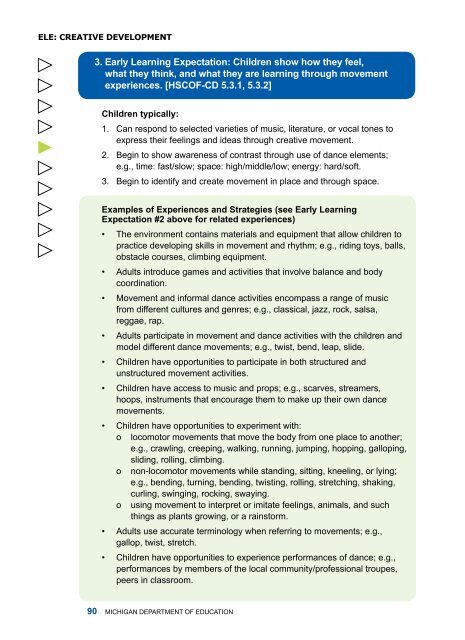Early Childhood Standards of Quality for ... - State of Michigan
Early Childhood Standards of Quality for ... - State of Michigan
Early Childhood Standards of Quality for ... - State of Michigan
Create successful ePaper yourself
Turn your PDF publications into a flip-book with our unique Google optimized e-Paper software.
ELE: Creative Development3. <strong>Early</strong> Learning Expectation: Children show how they feel,what they think, and what they are learning through movementexperiences. [HSCOF-CD 5.3.1, 5.3.2]Children typically:1. Can respond to selected varieties <strong>of</strong> music, literature, or vocal tones toexpress their feelings and ideas through creative movement.2. Begin to show awareness <strong>of</strong> contrast through use <strong>of</strong> dance elements;e.g., time: fast/slow; space: high/middle/low; energy: hard/s<strong>of</strong>t.3. Begin to identify and create movement in place and through space.Examples <strong>of</strong> Experiences and Strategies (see <strong>Early</strong> LearningExpectation #2 above <strong>for</strong> related experiences)• The environment contains materials and equipment that allow children topractice developing skills in movement and rhythm; e.g., riding toys, balls,obstacle courses, climbing equipment.• Adults introduce games and activities that involve balance and bodycoordination.• Movement and in<strong>for</strong>mal dance activities encompass a range <strong>of</strong> musicfrom different cultures and genres; e.g., classical, jazz, rock, salsa,reggae, rap.• Adults participate in movement and dance activities with the children andmodel different dance movements; e.g., twist, bend, leap, slide.• Children have opportunities to participate in both structured andunstructured movement activities.• Children have access to music and props; e.g., scarves, streamers,hoops, instruments that encourage them to make up their own dancemovements.• Children have opportunities to experiment with:o locomotor movements that move the body from one place to another;e.g., crawling, creeping, walking, running, jumping, hopping, galloping,sliding, rolling, climbing.o non-locomotor movements while standing, sitting, kneeling, or lying;e.g., bending, turning, bending, twisting, rolling, stretching, shaking,curling, swinging, rocking, swaying.o using movement to interpret or imitate feelings, animals, and suchthings as plants growing, or a rainstorm.• Adults use accurate terminology when referring to movements; e.g.,gallop, twist, stretch.• Children have opportunities to experience per<strong>for</strong>mances <strong>of</strong> dance; e.g.,per<strong>for</strong>mances by members <strong>of</strong> the local community/pr<strong>of</strong>essional troupes,peers in classroom.90 <strong>Michigan</strong> Department <strong>of</strong> Education


